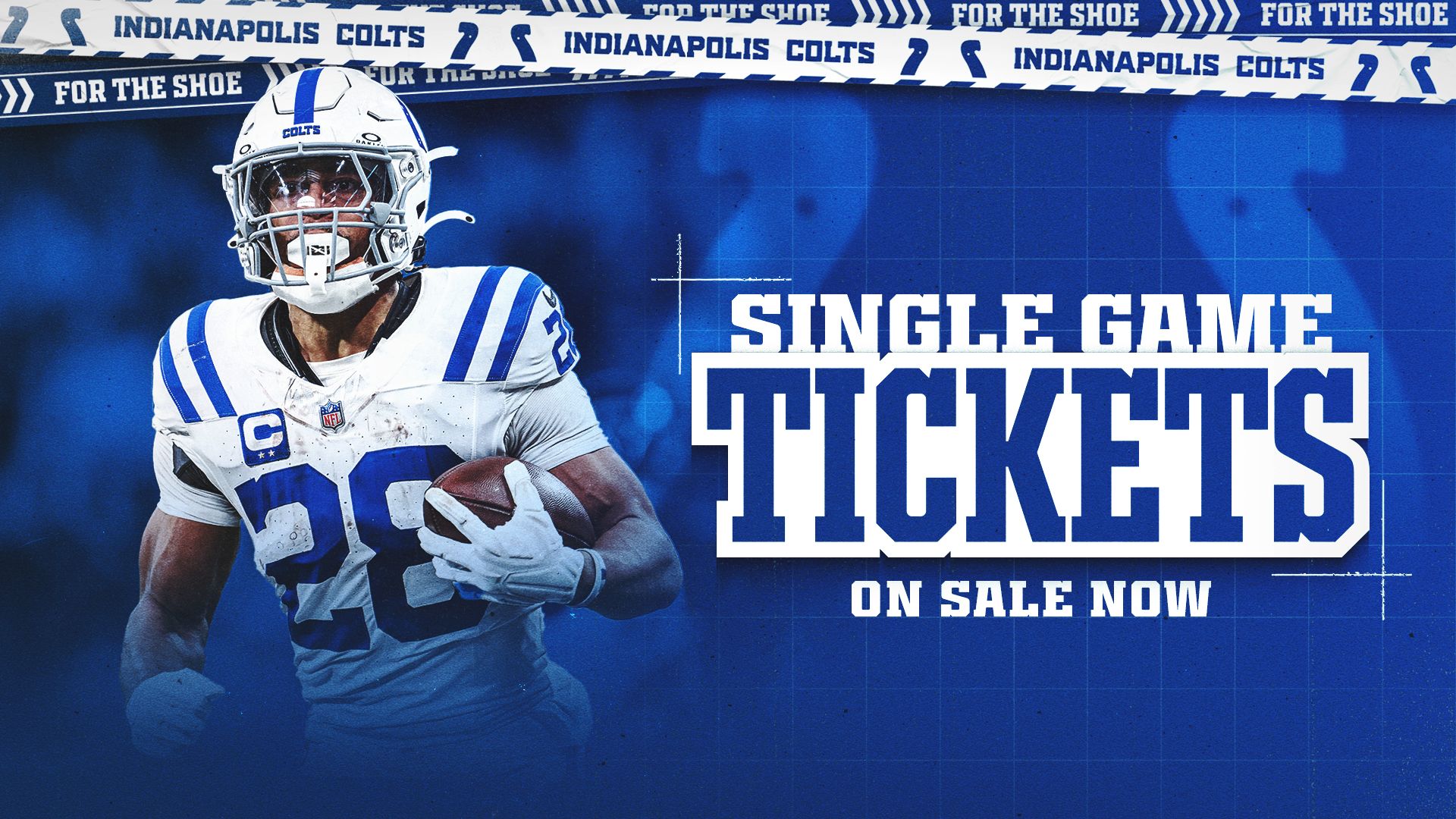We're back with another edition of The Colts Show Mailbag, where I'll answer listener questions both on the podcast and here on Colts.com every Thursday.
You can submit your questions to me a few ways: At Colts.com/Mailbag, on social media (like X and Instagram) and in the YouTube comments for the podcast.
For this week's podcast mailbag question, Larra Overton and I answered one from Nick Merlina about an under-the-radar position group that'll make a major impact on the Colts' success this season. For our answer, check out this week's episode of The Colts Show wherever you get your podcasts, including on:
Let's dive into the rest of this week's batch of questions:
Jeff Hickman (Terre Haute, Ind.): Why did we try to run the ball on 3rd and long so much last season, aren't we better off throwing a long shot and having some kinda chance?
JJ Stankevitz: Jeff has a good eye here, which allows me to get deep into the weeds on this – which is exactly where I want to be in mid-July.
Jonathan Taylor led the NFL in rushing attempts on third down with seven or more yards to go in 2024 (he had 12 such attempts). But let's dig into these numbers a bit to answer the second part of Jeff's question here about throwing the ball past the sticks in an attempt to get a first down.
Seven of those 12 runs came in extremely disadvantageous situations for the Colts' offense, like late-half third-and-15s or third-and-20-plus situations. But there were five attempts on traditional passing downs – third and 7-10 yards – that are worth looking at here. Taylor, by the way, also led the NFL with five rushing attempts on third down with 7-10 yards to go; no other player had more than three.
Here are those five attempts:
- Week 4 vs. PIT: 6:32 3rd quarter, 3rd and 7, ball on PIT 39-yard line: 3-yard gain
- Week 11 @ NYJ: 8:24 3rd quarter, 3rd and 9, ball on NYJ 38-yard line: 0-yard rush
- Week 15 @ DEN: 11:49 1st quarter, 3rd and 10, ball on DEN 38-yard line: 15-yard gain, first down
- Week 15 @ DEN: 1:51 1st quarter, 3rd and 9, ball on DEN 33-yard line: 10-yard gain, first down
- Week 17 @ NYG: 14:23 2nd quarter, 3rd and 8, ball on NYG 40-yard line: 5-yard gain
It's a small sample size, sure, but a 40 percent first down rate on these plays is notably right in line with what the Colts' first down rate was on quarterback dropbacks on third and 7-10 (39 percent; that rate does include scrambles and not just passing attempts).
Zooming out, the Colts were actually good at converting these plays into first downs last year compared to the rest of the league. The Colts had 79 third down plays with 7-10 yards to go, third-most in the NFL, but converted 37.2 percent of them, good for the ninth-highest rate in the NFL.
Third-and-long decisions teams make are hyper-dependent on situation and opponent (i.e., are we playing for a field goal, are we at a spot on the field where we can go for it on fourth down, does the score/time remaining mean we should punt, etc.). But to answer Jeff's question, last year for the Colts, they broadly were about as good at handing the ball to Taylor as they were having Anthony Richardson or Joe Flacco drop back; in all cases, they were pretty good at turning those plays into first downs.
Jerry Griffin (Cuba, Mo.): Do you think that the Colts' defense will be able to stop the run and pressure the QB in passing situations?
JJ Stankevitz: It's a time-tested football saying – you have to earn the right to rush the quarterback by stopping the run. The good news here is after some major issues in the first six quarters of the 2024 season, the Colts' defense for the most part rebounded against the run, finishing sixth in rushing success rate allowed on first and second down (24 percent). There was, though, some boom-or-bust to the Colts' run defense – they were 27th in explosive run rate allowed on early downs (12 percent) but were 7th in yards per rush allowed (4.0).
Cleaning up those explosive plays will be key for the Colts in 2024, as will generating more third-and-long opportunities to get after opposing quarterbacks. While the Colts' sack rate on third and 7+ last year was a little above league average, they were 29th in the NFL in pressure rate (36.2 percent) in those situations. Not all of that is on the defensive line – rush and coverage work together, especially in those situations – but it's a rate that will need to improve in 2025.
Trenton Freitag (Minneapolis): How do you see Tyler Warren fitting into this offense/in what way could he be used most effectively?
JJ Stankevitz: I can't wait to find out in training camp, but the thing with Warren is his skillset could lend itself to Shane Steichen using him in creative ways. He can line up with his hand in the dirt as a traditional in-line tight end, or he could be in a two-point stance detached from the line. He could line up in the backfield as a running back or wildcat quarterback. And, importantly, he has the football IQ to handle multiple responsibilities, as well as the complexities that come with motioning before the snap while still reading a defense.
Penn State head coach James Franklin did a fantastic job explaining all this on a podcast I did with him about Warren a few weeks back. Check it out here.
Steve Callandar (Westfield, Ind.): With Jaylon Carlies and Zaire Franklin both recuperating from injuries/surgeries, what is the likely Plan B at linebacker? Should we assume Segun Olubi can fill one of the starting spots? Should we expect the new scheme to routinely use two or three starting linebackers?
JJ Stankevitz: We'll see how the depth shakes out, but the Colts' linebacker reserves (Segun Olubi, Cameron McGrone, Joe Bachie, Liam Anderson, Austin Ajiake, Jacob Phillips, Solomon DeShields) got plenty of work during OTAs with Franklin and Carlies both out with injuries. Olubi, McGrone and Bachie have the most NFL experience, though most of it has been on special teams. We'll see how that shakes out during training camp.
I wanted to take this question though to answer the second part of it, with how many linebackers we can expect to start. This is going to be a noticeable change with Lou Anarumo taking over as defensive coordinator: Per Pro Football Focus, the 2024 Cincinnati Bengals had 98 defensive plays with three linebackers on the field (30th), while the Colts last year had 362 (fourth).
Let's get deeper into the weeds here.
Last year, the Bengals played the 10th most defensive snaps where they used nickel (two linebackers/five defensive backs) or dime (one linebacker/six defensive backs) against an opposing offense's 12 personnel (one back, two tight ends, two wide receivers) or 21 personnel (two backs, one tight end, two wide receivers). Traditionally, defenses will match heavier offensive personnel (two tight ends, a fullback, etc.) with heavier defensive personnel (more linebackers), but Anarumo stuck to leaning into their defensive backs in those situations.
That's also where the NFL is going – in 2024, teams averaged 150 defensive snaps in nickel/dime against 12/21 personnel; 10 years ago, the NFL average was 56 such plays; the Green Bay Packers led the NFL in 2014 with 148 of those plays, less than the league average in 2024.















